Prominent Minnesota auto writer leaves too soon
Filed under: Features, Autos
By John Gilbert
Those of us who have spent a lot of years writing about new cars lost a star out of our galaxy. just as the September of 2018 was yielding to the changing foliage of October, when Tony Swan died at age 78 after a long and intense battle with cancer,

Tony Swan, looking like he enjoyed the high-tech tools of being an auto journalist, was spotted in the San Antonio airport in April of 2017.
Weakened to a point of unwilling fragility after trying every potential method of fighting the insidious disease, Tony spent most of his final week in a gentle hospice facility near his home in Ypsilanti, Michigan. After final farewells to his devoted wife and partner, Mary, and insisting his gathered kids from an earlier marriage talk about seeing each other soon, rather than saying goodbye, Tony allowed himself to relax and slip away overnight.
For most of four decades, Tony Swan and I were the only two automotive writers from Minnesota. Times have changed, with a new generation of social-media types have blogged their way into the business, not always with proper responsibility in our estimation. We always discussed such matters because even though we had taken widely divergent paths to whatever status we attained, we remained close friends for something like 55 years, ever since we attended the University of Minnesota journalism school together back in the 1960s.
Those divergent paths were because Tony and I shared a love of cars, which led him on an upward spiral from AutoWeek to Popular Mechanics, Motor Trend and Car and Driver. My journalistic drive, so to peak, was split between hockey and sports writing on one hand and auto writing and motorsports on the other, a form of writing ambidexterity that made me determine to stay in Minnesota. In an odd way, we always had each other’s back, regardless of how scarce out time together was during my 30 years at the Minneapolis Tribune and later return home to Duluth for a couple of opportunities and more recent freelancing.
We always seemed to agree on things of true importance, but even the disagreements were noteworthy. You could debate or even argue with him for a while, remaining respectful and cordial, then suddenly Tony would look you in the eye and say: “Well, you’re wrong!”
End of discussion.
Tony lived his life by his own rules, and that carried over to friendships and arguments. Our mutual passion for motorsports led us both to pass road-racing schools at Sports Car Club of America venues when Showroom Stock Sedan racing started in the early 1970s. I did it for a year or two, and to this day employ some of the smart-driving techniques we learned there, while Tony continued racing a little, most recently in the low-budget “24 Hours of Lemons” series for cars with a $500 maximum value.
Tony mostly enjoyed keeping things simple behind the wheel. He was an excellent driver, and except for a few speeding tickets now and then, he didn’t overdo it on the streets. His personal car of choice? A Volkswagen GTI, the no-compromise performance model of the Golf. Inexpensive, comparatively speaking, and with a six-speed stick shift because it was most fun that way and, as a simple pleasure, it gave him total control.
Tony and Mary lived in Ypsilanti, Michigan, close enough to Detroit, the nation’s automotive nerve-center. At age 78, Tony had eased back from his writing at Car and Driver magazine; I was never sure it was his own call, because a new generation was taking over, and he kept free-lancing wherever he could.
Writers rarely talk or write about other writers, but I will. Anyone who read about cars for the last few decades has read something by Tony, in one of those “buff” magazines. Others will write about what a great guy he was, a warm human behind that curmudgeon-like demeanor. I will simply say that he was that, but he also was the most skillful writer for every publication he worked for.
Tony grew up in the western suburbs of Minneapolis, near Lake Minnetonka. He was a couple years older than I, and we hit it off because we both had cynical senses of humor, and we could crack each other up anytime we got together. I left for a two-year experience writing at the Duluth News Tribune, then accepted an offer from the prestigious sports department of the Minneapolis Tribune about the time Tony got a job writing sports at the St. Paul Pioneer Press.
The papers were bitter rivals, but Tony and I stay friends while competing in print, both covering hockey all winter and motorsports all summer. We never told our papers, but when we were sent off to cover Glen Sonmor’s University of Minnesota hockey team for a heated series with Badger Bob Johnson’s Wisconsin outfit, Tony and I would share a drive from Minneapolis to Madison. We kept each other awake, and in stitches, when we drove home through the night after the Saturday game. We’d make a stop for soup, a sandwich, or a piece of pie at Grandma Smrekar’s all-night cafe at Millston, Wis., and invariably we’d end up laughing like fools over something that a normal human might find inconsequential.
Tony left the Pioneer Press to join an attempt by a suburban paper into a special-edition sports scheme. It didn’t work and was disbanded, leaving Tony out of writing while I was on an upward trajectory writing sports and an automotive column for the Tribune. I was flattered that management, advertising, and, most importantly, readers enjoyed my take on both subjects.. Read more
Car-show kids: ‘Let’s play trucks!’
Filed under: Features, Autos
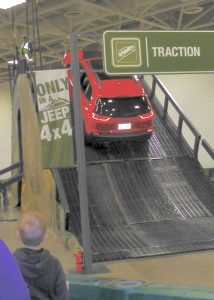
A young boy implored his family to stop and watch the Jeeps master the Camp Jeep obstacles at the Minneapolis Auto Show.
“Hey dad! Look! Look! LOOK,” the little voice grew bigger as the young lad yelled. His urgency demanded to interrupt his dad’s intention of casually wandering around the Minneapolis Convention Center to take in the Greater Minneapolis Auto Show.
The dad probably wanted to move along, but they weren’t going anywhere, for a while. The young boy had stopped, transfixed, next to Camp Jeep, which has got to be the best marketing ploy at this or any auto show. People can actually drive — ride with experts — in an assortment of new Jeep vehicles, including the Wrangler, Renegade, Compass, Cherokee and Grand Cherokee. But not just a ride. They follow the carefully built track that twists around and goes up and down at side angles, heading toward an amazingly steep hill, right there in the middle of Camp Jeep.
As the various Jeeps surged up the rise, we all stopped to see if it would make it. Of course they all did, up and over, disappearing over the other side. I have seen many Camp Jeeps, at many large auto shows, but it seems extra special right here in Minnesota, downtown Minneapolis. I was able to walk on, but the young dad and his little kid were still there — and might have remained right on through the March 18 final day of the show.
Kids love to play with cars and trucks, and it seems like the smaller the little boy, the more excited he is to watch every move a truck, or a Jeep, can make. In the grownup world, we are too confused to appreciate such simple pleasures.
For example, as I visited the Minneapolis show, I was road-testing two vehicles that were at the show. One was the all-new Toyota C-HR, the other a new Cadillac CT6 3.0 TT sedan.
Both are interesting. The CT6 is a beautifully designed sedan that seems traditionally Cadillac — long and low and shapely, with seriously engaging grille and headlights, and all the comfort and safety features you can imagine, along with a few that maybe you can’t. The C-HR is Toyota’s bid to try to capture some of the small-SUV fans who may be tempted to veer off course and buy a small Honda, or Mazda, or maybe even one of those somewhat odd Hyundai Velosters or Nissan Jukes.
The Veloster and Juke look like they might be related, with odd bulges and contours that are way out beyond the norm. Walk around the Veloster and you’d be impressed that it looks like a 4-door from the passenger side, but a 2-door from the driver’s side. It is, of course a 3-door, and Hyundai has just redesigned it to round off the bulgiest bulges for 2018.
If Toyota is taking on those outliers — as opposed to Outlanders — it has done the design part, because the C-HR looks like a prototype for all the new subcompact SUVs, and the price was right, at $24,000. However, up in the Great White North of Northern Minnesota, a lot of us think it’s borderline criminal to build an SUV-ish vehicle that is not an SUV. All-wheel drive is not available on the C-HR!
So it is an SUV-looking thing that is front-wheel-drive only, making it sporty in acceleration and lightweight, powered by its 2.0-liter with 144 horsepower and 139 foot-pounds of torque, but if you encounter a 12-inch snowfall in your driveway after driving home from the auto show, you might curse Toyota’s trendy maneuver.
The Cadillac CT6, on the other hand, has the potent new direct-injected dual-overhead-cam 3.0-liter V6 with cylinder deactivation — and, it does have all-wheel drive. In other words, we are confused enough that we now are looking at a full sail luxury sedan from Cadillac that can do the job of an SUV because it has got AWD, and an SUV-like compact from Toyota that can’t even pretend to be an SUV, because is hasn’t.
Meanwhile, the young lad doesn’t care about any of that stuff because he’s still transfixed by the Jeeps, which continue proving what you see is what you get, scrambling up those hills.
Camp Jeep now has spun off rivals. Mitsubishi, for example, also has a driving experience, promoting its comeback attempt with the Outlander, Outlander Sport, and its new Eclipse Cross. The Outlander PHEV is the first electric crossover SUV with all-wheel drive, and the Eclipse Cross has an available 1.5-liter turbo. Hyundai, meanwhile, is showing off its new Kona, a slick styling exercise that is more compact than the Tucson, and should go some, with a 1.6-liter turbo and Hyundai’s excellent dual-clutch 6-speed.
Ford is showing off its new Mustang Bullitt, a model to take advantage of the still-memorable movie “Bullitt” with Steve McQueen at the helm of a dark green Mustang. We’ve seen the new Bullitt before but both the Outlander PHEV and Eclipse Cross are making their public debuts at the Minneapolis show. That’s impressive for a show that is not one of the nation’s super shows, such as Detroit, Chicago, Los Angeles or New York. It’s put together by dealers in the Twin Cities, but it is the 15th largest show in the country, and they have caught on, employing a slick PR outfit, Nemer-Fieger, with an energetic young representative named Molly Steinke who has been doing her best to reach the media and entice them to visit the show. They also have a very neat program, with capsules on all the new cars you might be interested in, rather than just an ad-carrying sheet.
The Cadillac CT6 was a pleasure to drive from Duluth to the Twin Cities for the state high school hockey tournament, which, as usual, featured some games that could be put away in a time capsule to show all that’s good about living in Minnesota. It was a tough squeeze to fit in a Saturday morning at the auto show on press introduction day, and it was a shame to waste all that rear-seat room, which could easily accommodate two large adults in glorious luxury. With a turbocharger blowing through the 3.0 V6, the CT6 develops 404 horsepower and 300 foot-pounds of torque — more than the traditional top 3.6-liter V6.
Suspension and handling, to say nothing of the enormous trunk space, are exemplary in the Cadillac, although I would need about a month to get comfortable with its elaborate “CUE” system. You can, for example, figure out how to tune the radio without getting too many fingerprints on the big touchscreen, but while you’re figuring out what Cadillac was thinking with the complexity of controls that once were far easier with a round knob, be careful — if you sweep your finger across the dial, too close to the screen, you will make the volume go way up, or down, depending on which way you sweep.
The C-HR has plenty of pep from its 4-cylinder, and, after you fiddle with the adjustments enough, you learn that it has a control to allow you to be in normal, eco, or sport, and sport firms up the suspension and gives a dose more power to a touch of your toe, even though the CVT transmission will do its best to quell any sporting thoughts. Just as well, because the lack of AWD meets the drone of the CVT about halfway.
Meanwhile, back at the auto show, Chevrolet, Ford, Toyota, Mazda, Jaguar, Land Rover and Volkswagen are all offering brief test drives in assorted models.
Volkswagen has Jettas and Passats for test-drives. No, you can’t drive the new Alteon, but there is one on display, an impressive looking sedan that owes its sleek silhouette to being the replacement for the sleek but discontinued CC. The Alteon is pre-production and stays locked on the pedestal, while Volks is pushing test drives of its new Atlas, Alltrack, and Tiguan — VW’s posse of SUVs.
Yes, Volkswagen, perhaps the world’s most traditional maker of compact and subcompact cars with the Beetle, Rabbit and Golf, is now up to its headliner in SUVs.
And the little boy at Camp Jeep remains the only one not confused by it all.
Chicago Show: Cars, stars…and deep-dish pizza
Filed under: Equinox, Features, Autos
CHICAGO, IL.
There was a lot of talk about electric cars, hybrids, and autonomous (self-driving) vehicles, but the Chicago Auto Show best told the story of what car life in the U.S. is all about — trucks, SUVs…and more SUVs. One of the most impressive groups of new vehicles are the many midsize and compact crossovers.
After Toyota got things going with a display of high-performing off-road “TRD” models of its Tacoma and Tundra pickups, and its 4Runner SUV, Ford introduced the new generation of its Transit Connect, a compact, work-oriented mini-truck that fits and maneuvers in tight spaces and can be outfitted however a company or individual may choose.
To kick it off, Ford pulled a coup by having vice president Mark LaNeve call Jim Belushi to the stage, and Belushi walked out playing a harmonica and leading everyone in a spirited version of “Sweet Home, Chicago.” He intereviewed some in the audience, joked around with LaNeve, then enlisted him to join him in donning sunglasses to do a little Blues Brothers routine.
The versatility of the Transit Connect is that it could be everything from a foot truck, to a construction workers van, to a mini fun wagon, and while it doesn’t come in all-wheel drive, it does have a couple of new engines, including a 2.0-liter direct-injected 4 and a 1.5 -liter EcoBlue diesel engine with a new 8-speed automatic.
The Chicago Auto Show is the largest and longest-running auto show in the country, and in the opinion of everyone who attends, it also is by far the most fun of the major domestice shows. The lively nightlife scene and legendary restaurants help that reputation. The 110th Chicago Auto Show opened with media days in a nasty blizzard that lasted a day and a half and cancelled 600 flights into and out of O’Hare Airport — and it was still fun. It opened to the public on February 10 and anyone looking for a new car can spend hours examining everything offered in showrooms across the country on the 1,000-square-foot halls in McCormick Place, as it runs through Monday, Feb. 19.
Because it is definitely a consumer-driven show, Chicago provides an ample number of vehicles that appeal to mainstream, grassroots buyers. Its media survey to pick the Family Car of the Year came in with the Honda Odyssey, the latest generation of the popular and feature-filled minivan, which beat out other valid contenders including the Volvo XC-60 SUV, a midsize version of its SUV-of-the-Year XC-90.
There were not a lot of new introductions, after most of the debuts were spent on the Los Angeles show in November, and at Detroit in January. But there were definitely still some standouts, for the show, which got a rejuvenated restart in 1950 after the auto industry got rolling again following World War II.
With special attractions virtually every day, the Chicago show undoubtedly will be the best-attended show, again.
Consumers, of course, care less about the show-biz schemes than about sitting in and scrutinizing the cars. Read more
Light on new cars, Detroit show features trucks
Filed under: Equinox, Features, Autos
By John Gilbert
DETROIT, Michigan
Call it “Auto Show Light,” but the North American International Auto Show, formerly known simply as the Detroit Auto Show, seems to have gone on a diet, as the latest example of how the automotive world is changing. Swamped by the consumer tide of sports-utility vehicles rising above and beyond mere cars, much in the way the nation’s most prestigious auto show has added words in hopes of adding prestige to its name.
While spectacular new cars were fewer, there certainly were still some compelling introductions during the annual press previews on Monday and Tuesday, January 15-16, with the public show following through the following two weekends. But trucks had the upper hand.
Ram rolled out an impressive new 1500 pickup truck, with the massive, macho facade replaced by a far more refined grille and completely redone interior, with a giant vertical navigation/information screen about the size of a full-size iPad.
The new rounded-off look is a departure, and it was interesting that the new Ram won “Best in Show” from the respected auto website cars.com, and perhaps it was verification of how few new cars there were, since the Los Angeles Show in November, that pickups won several awards.
Ford offered a hybrid version of its new F150 pickup and made big news affirming the much-rumored return of the midsize Ranger pickup, which not only was a highlight of the show, but was a co-dominating model alongside a couple of new Mustang versions.
Honda’s Acura luxury division called it a concept, but the new generation of the RDX compact SUV made a strong impression, as trucks and trucklings dominated. Also, there were a number of concept vehicles — including one each from Nissan and its upscale Infiniti brand — and Toyota’s Lexus also showed a concept sporty SUV. Read more
Let’s say you select your own car, truck of the year
Filed under: Features, Autos
By John Gilbert
One of the highlights of every year, for a media auto fanatic, is to attend the North American International Auto Show at Detroit’s Cobo Hall. Traditionally the largest and most spectacular of the four “major” U.S. shows — along with Los Angeles, Chicago and New York — the Detroit show has the added attraction of being the center of the automotive universe, attracting engineers, designers and the usual overload of promotional types.
There are bigger shows worldwide, such as the Frankfurt Auto Show, which I’ve attended several times, and probably Tokyo, Paris, or Geneva, which I’ve never attended, but the Detroit show draws the auto company big-shots from all over the world, many of whom have their North American headquarters in or near Detroit, which, of course, is the home base for Ford, General Motors and FCA, or Fiat Chrysler Automobiles.
The Detroit show starts January 13th, and after three press conference dates, opens to the public. It has lost some of its luster in recent years, through no fault of its own. The Los Angeles show, held in November, upstages Detroit by attracting a lot of the Asian introductions, which has forced other countries, and the U.S. manufacturers, into also sending a preponderance of their “A” material to L.A. Chicago, meanwhile, is the most fun, because of the assortment of high-end restaurants and music venues in a tight little area accessible to the media and other major hotels. New York is reat fun, but it is scattered around Manhattan and may be completely overlooked by the locals.
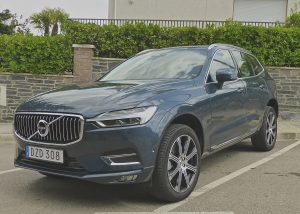
The Volvo XC-60 takes all the assets of the exceptional XC-90 and condenses them into the best SUV on the market — our truck of the year.
Detroit, however, remains the mainstay, and among the major attractions in Detroit is the naming of the North American Car of the Year, Truck of the Year, and Utility of the Year, as voted on by an independent jury of auto media types.
In the two decades I was part of that jury, I tried to influence all who would listen about improving the stature of the car of the year award. The jury did follow my strong suggestion about having a re-vote after naming the finalists, to encourage more coverage among jury members. I did originally think going to a separate category for utility vehicles made sense, but I reversed myself after some serious thought, when I realized that the rapidly expanding surge of SUVs was about to be accompanied by a reduction in legitimate trucks. Read more


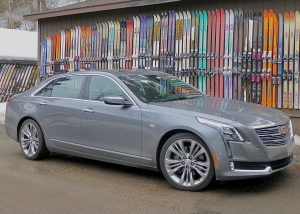
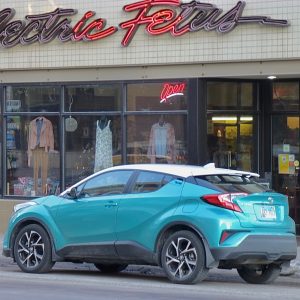
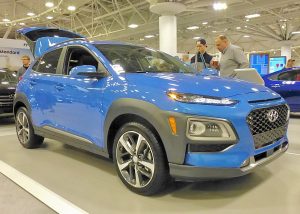

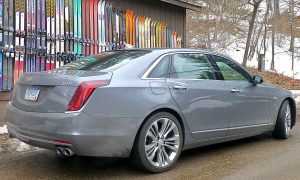
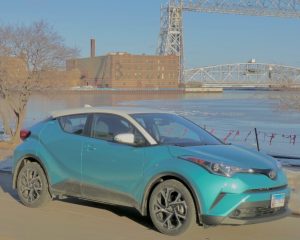
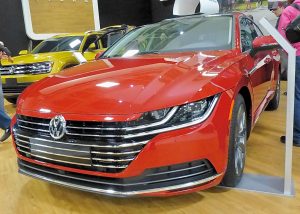
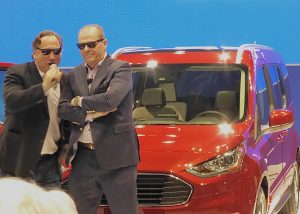
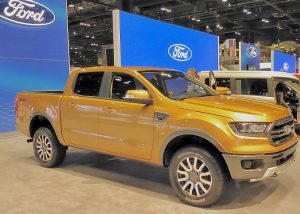
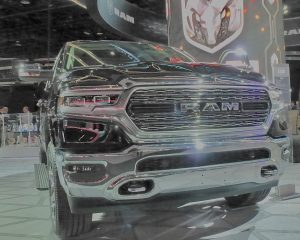
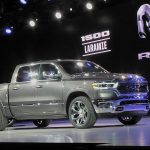
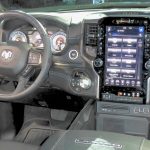
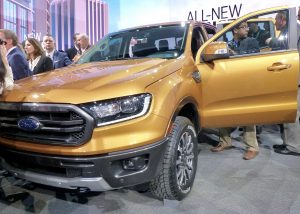
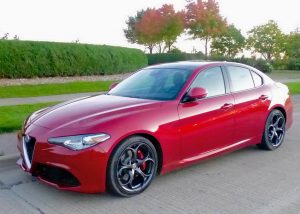
 John Gilbert is a lifetime Minnesotan and career journalist, specializing in cars and sports during and since spending 30 years at the Minneapolis Tribune, now the Star Tribune. More recently, he has continued translating the high-tech world of autos and sharing his passionate insights as a freelance writer/photographer/broadcaster. A member of the prestigious North American Car and Truck of the Year jury since 1993. John can be heard Monday-Friday from 9-11am on 610 KDAL(www.kdal610.com) on the "John Gilbert Show," and writes a column in the Duluth Reader.
John Gilbert is a lifetime Minnesotan and career journalist, specializing in cars and sports during and since spending 30 years at the Minneapolis Tribune, now the Star Tribune. More recently, he has continued translating the high-tech world of autos and sharing his passionate insights as a freelance writer/photographer/broadcaster. A member of the prestigious North American Car and Truck of the Year jury since 1993. John can be heard Monday-Friday from 9-11am on 610 KDAL(www.kdal610.com) on the "John Gilbert Show," and writes a column in the Duluth Reader.